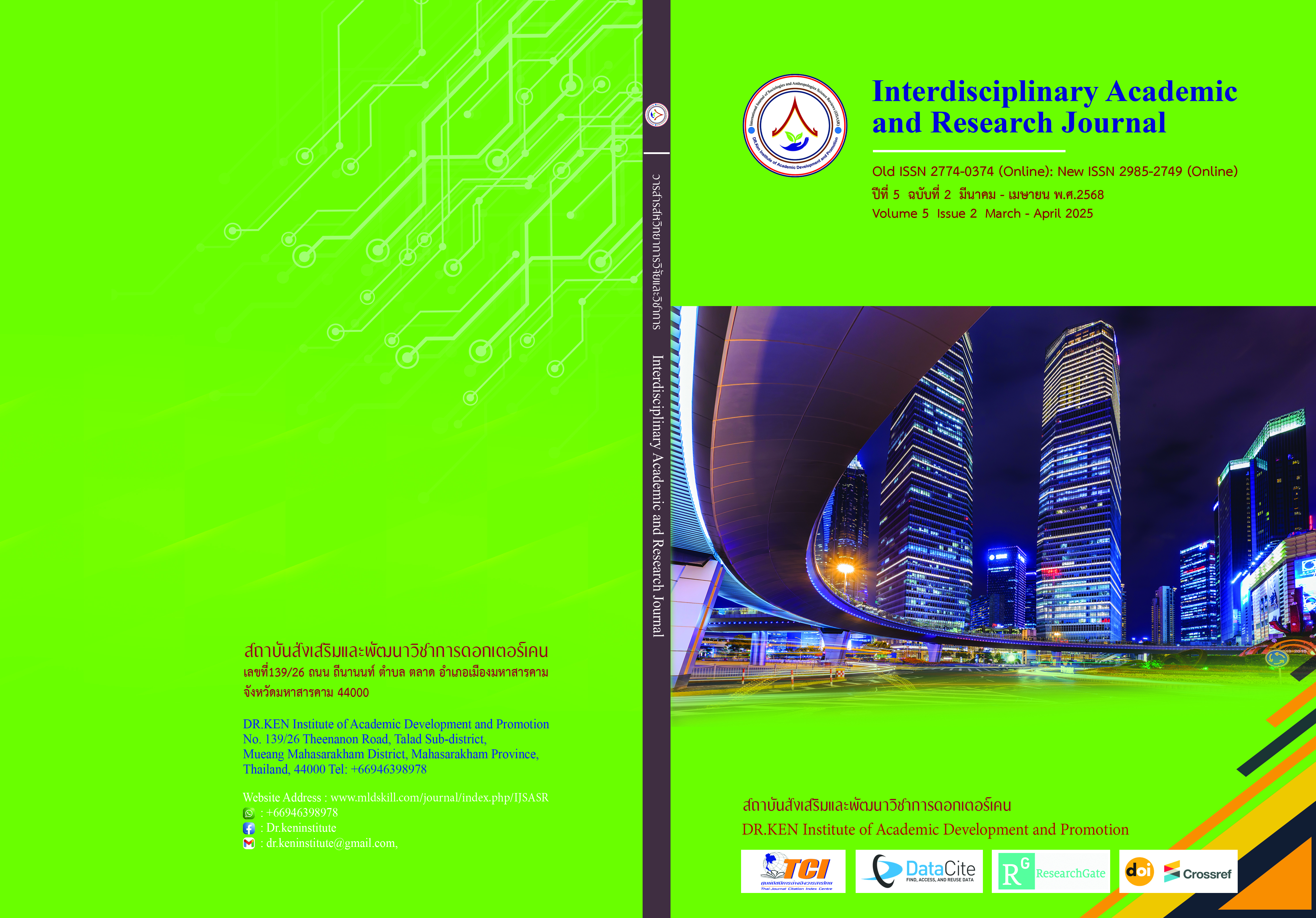The Model of Development for Academic Leadership of Teachers under the Office of Roi Et Primary Educational Service Area 2
DOI:
https://doi.org/10.60027/iarj.2025.281589Keywords:
A Development Model, Academic Leadership, TeachersAbstract
Background and Aims: Academic leadership of teachers refers to the professional behaviors exhibited by teachers that demonstrate advanced and up-to-date academic knowledge, as well as continuous self-improvement through seeking, learning, and acquiring new knowledge. These behaviors also include the ability to impart this knowledge to students or share and exchange learning with colleagues and others. Therefore, the objectives of this research are as follows: 1) to study the components and indicators of academic leadership of teachers. 2) to study the current situation, desirable condition and priority needs of academic leadership of teachers. 3) create a model of development for the academic leadership of teachers. 4) to study the results of using the model of development for academic leadership of teachers.
Methodology: The research was divided into four phases: Phase 1: Study of components and indicators of academic leadership of teachers. A group of 9 key informants was involved to verify and confirm the components and indicators. Phase 2: Study of the current condition, desired condition, and priority needs for academic leadership of teachers. The sample group consisted of 385 school administrators and teachers. The research tool was a questionnaire with an overall reliability of .79. Data were analyzed using mean and standard deviation. Phase 3: Creation and create a model of development for academic leadership of teachers. A group of 12 key informants was involved to evaluate the suitability, feasibility, and usefulness of the model. Phase 4: Study of the results of the implementation of the model of development for academic leadership of teachers. The target group is 19 teachers in schools under the Office of Roi Et Primary Educational Service Area 2.
Results: 1. The components and indicators of academic leadership for teachers: There are 4 components: Being a role model in teaching, Student Development, Professional teaching skills, and Participation in educational quality improvement. 2. The overall current state has an average rating at a high level. The overall desired state has an average rating at the highest level. The priority needs index is ranked from highest to lowest as follows: Student development, Professional teaching skills, Participation in educational quality improvement, and Being a role model in teaching. 3. The model of development for academic leadership consists of 4 modules, Module 1 student development, Module 2 professional teaching skills, Module 3 participation in educational quality improvement, and Module 4 being a role model in teaching. The overall evaluation of the model’s suitability, feasibility, and usefulness has an average rating at the highest level. 4. Results of using the model: The overall implementation of the model based on the indicators is at the highest level. The satisfaction evaluation of the experimental group using the model shows the highest level of satisfaction overall.
Conclusion: Academic leadership of teachers is considered crucial for advancing academic leadership in line with professional standards and promoting teachers as global professionals. Academic leadership of teachers reflects the collaborative efforts of teachers in fostering collective learning and mutual knowledge exchange. It involves creativity in teaching and learning practices, leading to real-world application in schools. This process contributes to the improvement of student learning and positions teachers as leaders in teaching and learning. The key components of academic leadership of teachers include: 1) student development, 2) professional teaching skills, 3) participation in educational quality improvement, and 4) being a role model in teaching.
References
กระทรวงศึกษาธิการ. (2551). ภาระงานของครู. กรุงเทพฯ: กระทรวงศึกษาธิการ.
กระทรวงศึกษาธิการ. (2560). แผนพัฒนาการศึกษาของกระทรวงศึกษาธิการฉบับที่ 12 (พ.ศ. 2560-2564). กรุงเทพฯ: พริกหวานกราฟฟิค.
ปรียาพร วงศ์อนุตรโรจน์. (2553). การบริหารงานวิชาการ. กรุงเทพฯ: สำนักพิมพ์พิมพ์ดี.
ไพฑูรย์ สินลารัตน์. (2559). การศึกษา 4.0 เราต้องแปลงกับดักให้เป็นความหวังดี การศึกษา 4.0 เป็นยิ่งกว่าการศึกษา. กรุงเทพฯ: โรงพิมพ์แห่งจุฬาลงกรณ์มหาวิทยาลัย.
วรากรณ์ สามโกเศศ และคณะ. (2553). ข้อเสนอระบบการศึกษาทางเลือกที่เหมาะสมกับสุขภาวะคนไทย. กรุงเทพฯ: ภาพพิมพ์.
วัญญา วิศาลาภรณ์. (2540). การวิจัยทางการศึกษา : หลักการและแนวทางการปฏิบัติ. กรุงเทพฯ: ต้นอ้อแกรมมี่.
วาโร เพ็งสวัสดิ์. (2552). การวิจัยและการพัฒนา. วารสารมหาวิทยาลัยราชภัฏสกลนคร, 1(2), 1–12. Retrieved from https://ph01.tci-thaijo.org/index.php/snru_journal/article/view/10186
วิมล จันทร์แก้ว. (2555). รูปแบบการพัฒนาภาวะผู้นำเชิงสร้างสรรค์ของผู้บริหารสถานศึกษา สังกัดสำนักงานเขตพื้นที่การศึกษาประถมศึกษา สุราษฏร์ธานี เขต 3. วิทยานิพนธ์ศึกษาศาสตรดุษฎีบัณฑิต. ปทุมธานี: มหาวิทยาลัยรังสิต.
สำนักงานคณะกรรมการการศึกษาขั้นพื้นฐาน. (2564). นโยบายสำนักงานคณะกรรมการการศึกษาขั้นพื้นฐาน ปีงบประมาณ พ.ศ. 2564. Retrieved from: https://www.obec.go.th/wp-content/ uploads/2018/10/OBECPolicy62.pdf
สำนักงานเลขาธิการคุรุสภา. (2558). มาตรฐานวิชาชีพทางการศึกษา. กรุงเทพฯ: สำนักงานเลขาธิการคุรุสภา.
สำนักงานเลขาธิการสภาการศึกษา. (2564). รายงานการศึกษาการพัฒนาคุณภาพผู้เรียนจากผลการทดสอบ O-NET และ PISA. กรุงเทพฯ: สำนักงานเลขาธิการสภาการศึกษา.
สุวิมล ว่องวาณิช. (2552). การวิจัยประเมินความต้องการจำเป็น. กรุงเทพฯ: สำนักพิมพ์แห่งจุฬาลงกรณ์มหาวิทยาลัย.
อาภารัตน์ ราชพัฒน์. (2554). การพัฒนาตัวบ่งชี้ภาวะผู้นาของครูในสถานศึกษาขั้นพื้นฐาน. (วิทยานิพนธ์ปรัชญาดุษฎีบัณฑิต). ขอนแก่น: มหาวิทยาลัยขอนแก่น.
อุทัย บุญประเสริฐ. (2552). การวิจัยด้านการจัดการการศึกษา : แก่นการจัดการการศึกษา. พิมพ์ครั้งที่ 2. กรุงเทพฯ: พิมพ์ลักษณ์.
Childs-Bowen, D., Moller, G., & Scrivner. J. (2000). Principals: leaders of leaders. NASSP Bulletin, 84(6), 27-34. doi:10.1177/019263650008461606
Dimmock, C., & Walker, A. (2005). Educational leadership: culture and diversity. Gateshead: Athenaeum Press.
Eisner, E. (1976). Education connoisseurship and criticism: Their form and function in education evaluation. Journal of Aesthetic Education, 10(3/4), 135-150.
Fullan, M. (1993). Change Forces: Probing the Depths of Educational Reform. London: Falmer Press.
Katzenmeyer, M., & Moller, G. (2001). Awakening the Sleeping Giant: Helping Teachers Develop as Leaders. 2nd ed. Thousand Oaks. CA: Corwin.
Krejcie, R.V., & D.W. Morgan. (1970). “Determining Sample Size for Research Activities”. Educational and Psychological Measurement. 30(3), 607 – 610.
Leithwood,K.,& Duke,D.L (1999). A century’s quest to understand school leadership. In J. Murphy & K.S. Louis (eds). Handbook of Research on Educational Administration. San Francisco: Jossey-Bass Publishers.
McCauley, C. (1998). When screen violence is not attractive. In J. H. Goldstein (Ed.), Why we watch: The attractions of violent entertainment (pp. 144–162). Oxford University Press.
Muijs, D., & Harris, A. (2006). Teacher led school improvement: Teacher leadership in the UK. Teaching and Teacher Education, 22(8), 961-972
Pellicer, L. O. and Anderson, L. W. (1995). A handbook for teacher leaders. Thousand Oaks, CA: Corwin Press.
Sherrill, J. (1999). Preparing teachers for leadership roles in the 21st century. Theory into Practice, 38(1), 56–61.
Strodl, P. (1992). A model of teacher leadership. Paper presented at the annual meeting of the Eastern Educational Research Association, Hilton Head, SC.
Suranna, K. J., & Moss, D. M. (2002). Exploring teacher leadership in the context of teacher preparation. Paper presented at the annual meeting of the Educational Research Association, New Orleans. LA. (ERIC Document Reproduction Service No. ED465751).
Vicere, Albert A. and Fulmer, Robert M. (1998). Leadership by Design Hardcover. Harvard Business School Press.
York-Barr, J., & Duke, K. (2004). What Do We Know About Teacher Leadership? Findings From Two Decades of Scholarship. Review of Educational Research, 74(3), 255-316. https://doi.org/10.3102/00346543074003255
Downloads
Published
How to Cite
Issue
Section
License
Copyright (c) 2025 Interdisciplinary Academic and Research Journal

This work is licensed under a Creative Commons Attribution-NonCommercial-NoDerivatives 4.0 International License.
Copyright on any article in the Interdisciplinary Academic and Research Journal is retained by the author(s) under the under the Creative Commons Attribution-NonCommercial-NoDerivatives 4.0 International License. Permission to use text, content, images, etc. of publication. Any user to read, download, copy, distribute, print, search, or link to the full texts of articles, crawl them for indexing, pass them as data to software, or use them for any other lawful purpose. But do not use it for commercial use or with the intent to benefit any business.














.png)

